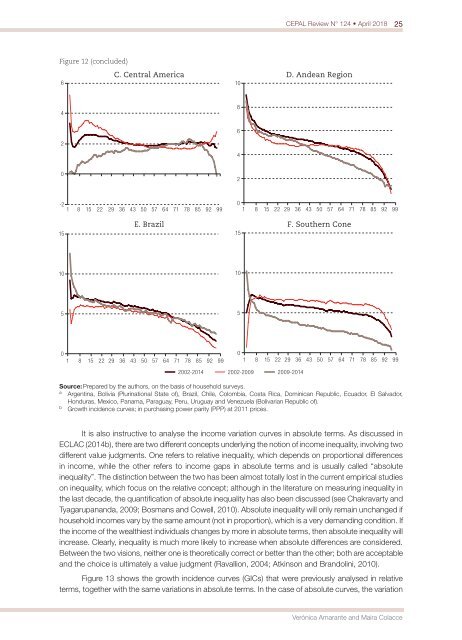CEPAL Review no. 124
April 2018
April 2018
Create successful ePaper yourself
Turn your PDF publications into a flip-book with our unique Google optimized e-Paper software.
<strong>CEPAL</strong> <strong>Review</strong> N° <strong>124</strong> • April 2018<br />
25<br />
Figure 12 (concluded)<br />
6<br />
C. Central America<br />
10<br />
D. Andean Region<br />
4<br />
8<br />
6<br />
2<br />
4<br />
0<br />
2<br />
-2<br />
1 8 15 22 29 36 43 50 57 64 71 78 85 92 99<br />
0<br />
1 8 15 22 29 36 43 50 57 64 71 78 85 92 99<br />
15<br />
E. Brazil<br />
15<br />
F. Southern Cone<br />
10<br />
10<br />
5<br />
5<br />
0<br />
1 8 15 22 29 36 43 50 57 64 71 78 85 92 99<br />
0<br />
1 8 15 22 29 36 43 50 57 64 71 78 85 92 99<br />
2002-2014 2002-2009 2009-2014<br />
Source: Prepared by the authors, on the basis of household surveys.<br />
a<br />
Argentina, Bolivia (Plurinational State of), Brazil, Chile, Colombia, Costa Rica, Dominican Republic, Ecuador, El Salvador,<br />
Honduras, Mexico, Panama, Paraguay, Peru, Uruguay and Venezuela (Bolivarian Republic of).<br />
b<br />
Growth incidence curves; in purchasing power parity (PPP) at 2011 prices.<br />
It is also instructive to analyse the income variation curves in absolute terms. As discussed in<br />
ECLAC (2014b), there are two different concepts underlying the <strong>no</strong>tion of income inequality, involving two<br />
different value judgments. One refers to relative inequality, which depends on proportional differences<br />
in income, while the other refers to income gaps in absolute terms and is usually called “absolute<br />
inequality”. The distinction between the two has been almost totally lost in the current empirical studies<br />
on inequality, which focus on the relative concept; although in the literature on measuring inequality in<br />
the last decade, the quantification of absolute inequality has also been discussed (see Chakravarty and<br />
Tyagarupananda, 2009; Bosmans and Cowell, 2010). Absolute inequality will only remain unchanged if<br />
household incomes vary by the same amount (<strong>no</strong>t in proportion), which is a very demanding condition. If<br />
the income of the wealthiest individuals changes by more in absolute terms, then absolute inequality will<br />
increase. Clearly, inequality is much more likely to increase when absolute differences are considered.<br />
Between the two visions, neither one is theoretically correct or better than the other; both are acceptable<br />
and the choice is ultimately a value judgment (Ravallion, 2004; Atkinson and Brandolini, 2010).<br />
Figure 13 shows the growth incidence curves (GICs) that were previously analysed in relative<br />
terms, together with the same variations in absolute terms. In the case of absolute curves, the variation<br />
Verónica Amarante and Maira Colacce


















